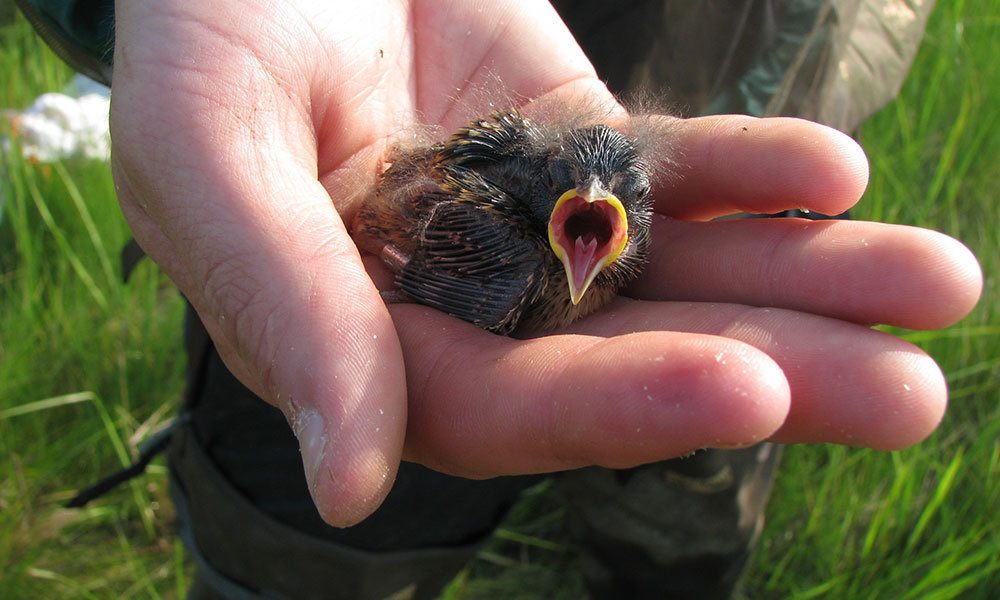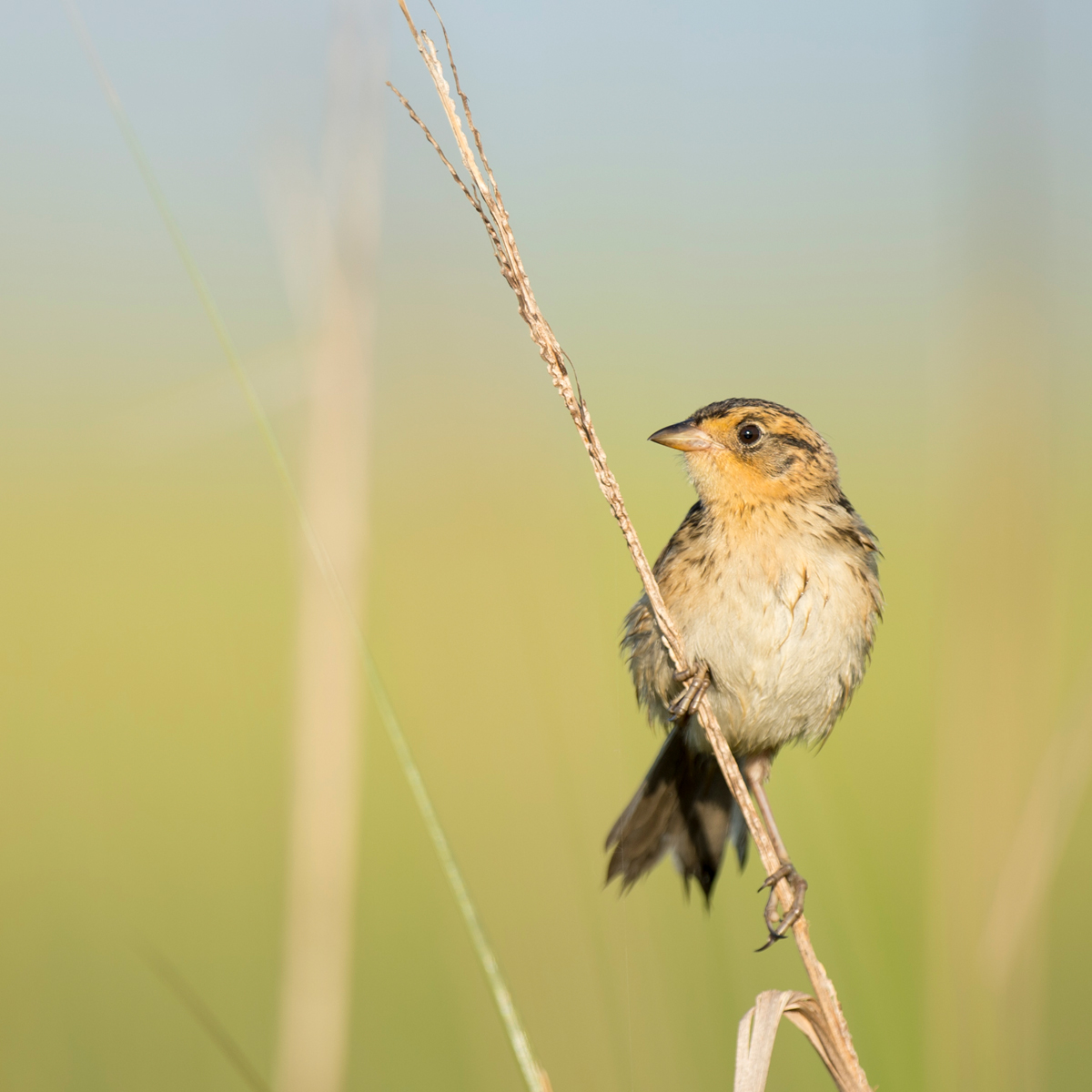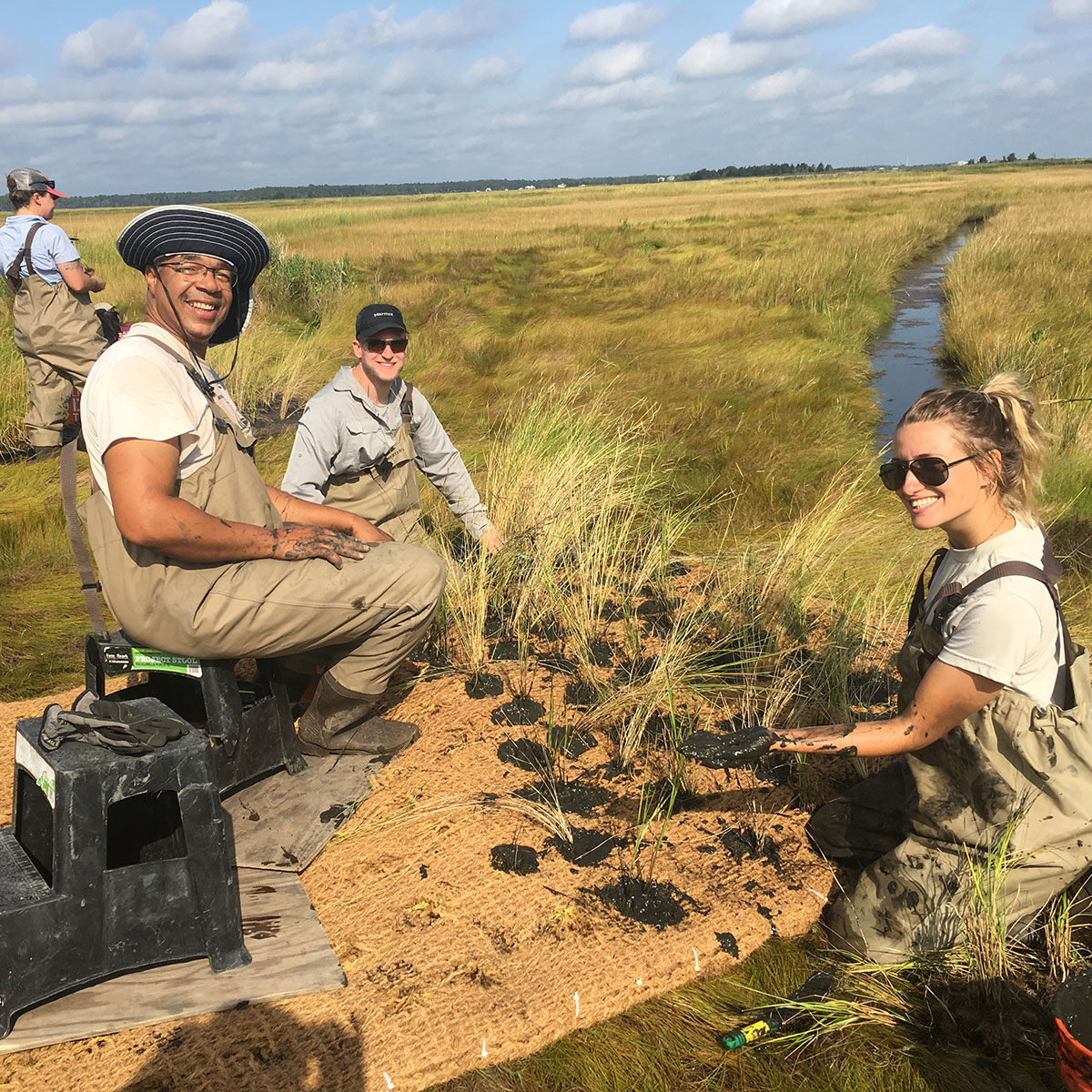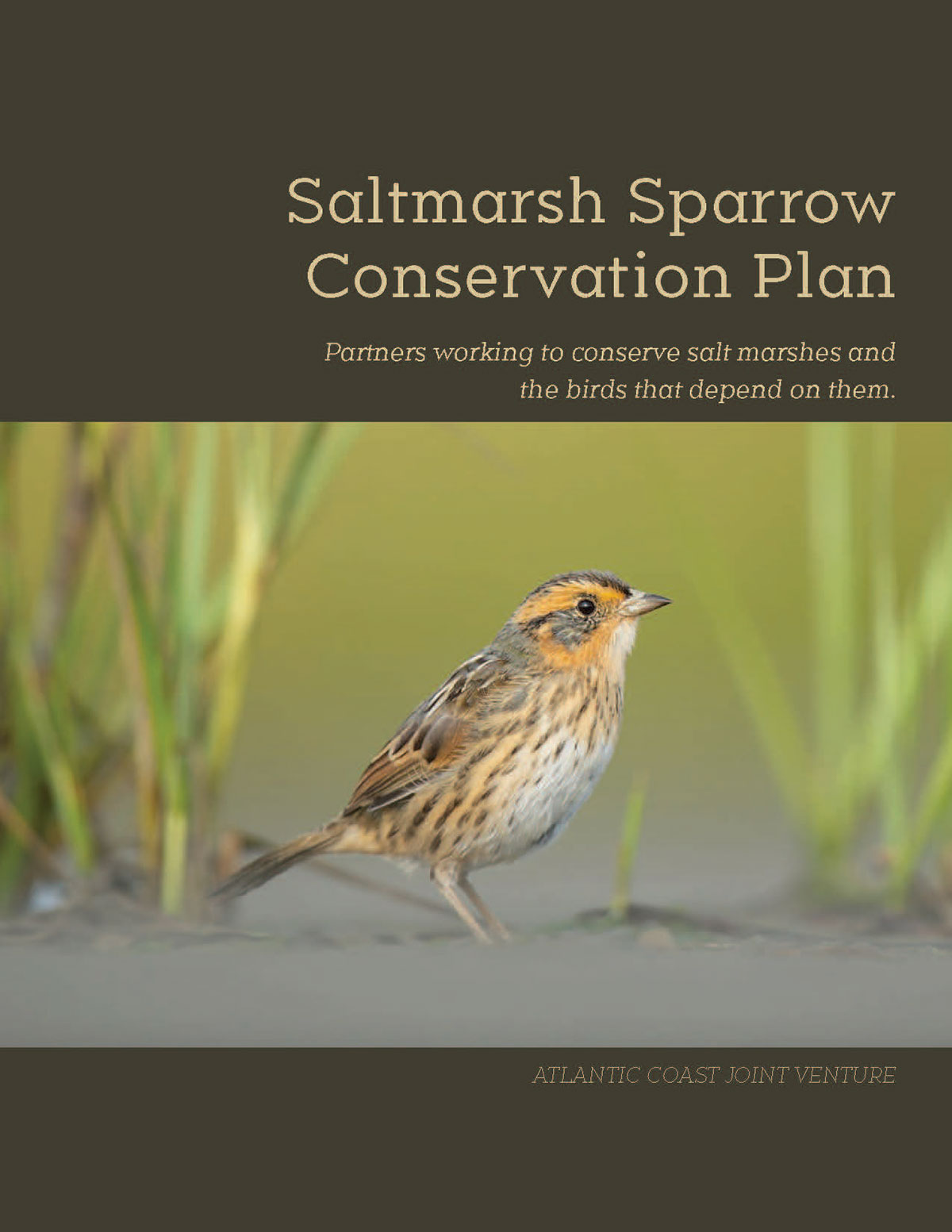Our Conservation Approach
Conservation Need
The Saltmarsh Sparrow is a tidal marsh songbird and the only bird species endemic to the ACJV; it is found nowhere else on earth. Their small population (~60,000 individuals in 2012) has been declining at an alarming rate of 9% per year since the 1990s. Under the current trend, scientists suggest that the population could collapse within 50 years unless something is done to stabilize the downward spiral.

Saltmarsh Sparrow (Ammospiza caudacuta)
Photo: Mike Kilkpatrick
Our Objective
The ACJV has adopted a long-term population objective of sustaining 25,000 breeding birds. To halt the steep population decline and recover the Saltmarsh Sparrow population we must:
- restore and enhance existing salt marshes to provide high-quality nesting habitat on at least 84,000 acres of salt marsh; and
- protect adjacent, inland areas to allow marshes to migrate as sea levels rise.

Threats
Saltmarsh Sparrows nest in high marsh grasses just above the mean high tide line. They have naturally adapted to occasional flooding events; eggs can survive short periods of inundation and young birds often climb to safety in the grass above the nest. However, more than a foot of sea-level rise in some parts of their range has caused nests to flood more frequently and by higher water, overwhelming these highly adaptive traits. Nest flooding is the greatest threat to their nest success followed by depredation of eggs and young.
Achieving Our Objective
A series of state-level management guidance documents and a regional map have been created for the Saltmarsh Sparrow breeding range. They identify priority marshes and restoration actions to explore at each marsh. These actions are urgent and must be accomplished by 2032 in order to meet short term population goals.
The estimated cost of implementing these actions is ~$2B – or $200M per year between 2022 and 2032.
Science Priorities and Objectives
The Atlantic Coast Joint Venture is always working to identify next steps in the science needed to guide successful management and implementation of our conservation plan on the ground. Currently we are working to forward the following science initiatives / next steps to support Saltmarsh Sparrow conservation:
- Updated vegetation community layer (including validation) and sea level rise projections into the future for Atlantic coastal marshes
Coordinated monitoring protocols for saltmarsh restoration (initial planning underway by USFWS) - Peer-reviewed research exploring the direct link between past human modifications to the marsh (e.g. tidal restrictions, ditching) on marsh lifespans
- Explore the relationships between Saltmarsh Sparrow occupancy, abundance, and reproductive activity/success and saltmarsh restoration efforts
- Peer-reviewed research predicting occupancy and density of saltmarsh sparrows within their global breeding range
- Updated population estimates and trends for Saltmarsh Sparrow using recently collected survey data
- Heightened understanding of habitat use and needs on the wintering grounds
- Regional prioritization layer for restoration implementation
Check out your state here:

Saltmarsh Sparrow photo by Ray Hennessey
Salt Marsh Management Techniques
The highest-priority management practices for Salt Marsh birds include:
Runneling of Drowning Marshes – Creation of a shallow channel used to remove impounded water from the marsh surface.
Restoring Ditched Marshes – The modification of ditch structure within a marsh to improve marsh hydrology and sediment retention.
Sediment placement on the marsh platform – The application of dredged or upland sediments to the marsh surface for the purpose of increasing marsh elevation. “Thin layer deposition” (TLD) refers to deposition of up to 6-8 inches of sediments and through which the underlying marsh vegetation can grow.
Increasing Microtopography – Create patches of increased elevation to provide areas on the marsh platform that may offer nesting habitat that is less prone to flooding.
Planning Tools & Resources
» Saltmarsh Sparrow Priorities – Spatial Hub
Includes a variety of maps accessed by buttons on a main landing page
»Saltmarsh Sparrow Project Inventory
A catalog of Saltmarsh Sparrow restoration, management, and enhancement projects throughout the Atlantic Coastal region.
̱ Project Inventory Form
Enter your project information to help track our success.
» SHARP program website
The Salt Marsh Habitat and Avian Research Program website is a hub of Saltmarsh Sparrow research, data, monitoring protocols and more.

Marsh mat planting project at Forsythe National Wildlife Refuge
News, Media & Helpful Resources
- Healing a Marsh in Connecticut: Reviving the Largest Saltmarsh in New England
- Thin Layer Deposition: One person’s trash is another person’s treasure – How dredged sediments can help rebuild drowning coastal marshes.
- Runnelling: Rising to the Challenge: Salt marsh restoration to heal historic wounds and combat climate change
- Runnelling: Building Great Marsh resiliency from the bottom-up
Read how biologists are healing human-made scars in tidal systems from colonial-era farming to 20th-century mosquito control. - Podcast: USFWS Talk on the Wildside Podcast: Episode 5 is about wetlands and includes a story about Saltmarsh sparrow and waterfowl habitat.
- PBS video clip on Saltmarsh Sparrow: Check out this very cool PBS video clip on saltmarsh birds and how they manage living in a tidal system.
- One person’s trash is another person’s treasure – How dredged sediments can help rebuild drowning coastal marshes
- Rising to the Challenge: Salt marsh restoration to heal historic wounds and combat sea-level rise
- Building Great Marsh resiliency from the bottom-up
Read how biologists are healing man-made scars in tidal systems from colonial-era farming and 20th-century mosquito control. - USFWS Talk on the Wildside Podcast: Episode 5 is about wetlands and includes a story about Saltmarsh sparrow and waterfowl habitat.
- The New York Times wrote about the Saltmarsh Sparrow’s Fight to Keep Their Heads Above Water
- Webinar: Saltmarsh Sparrow Conservation in the North Atlantic Appalachian Region
- Webinar: Saltmarsh Sparrow Habitat Patch Priority Prioritization Tool
- Webinar: Three New Products for Saltmarsh Sparrow Conservation
- Webinar: Farmers in the Marsh
- Webinar: Saltmarsh Revegetation Through Runels
- Webinar: Using Dredged Sediment to Create Vanishing Habitats and Restore Tidal Wetlands
- NEAFWA Workshop Resources Document
Recent Posts
Flagship Update 2024 – Saltmarsh Sparrow
Coastal Marsh Restoration: An Ecosystem approach for the Mid-Atlantic In 2024 we co-authored a document with the National Oceanic and Atmospheric Association (NOAA) and partners within the US Fish and Wildlife Service to address [...]
Flagship Update 2023 – Saltmarsh Sparrow
Recommendations for Monitoring Saltmarsh Sparrows on Salt Marsh Restoration Projects Saltmarsh Sparrow Restoration Monitoring Guidance This year the ACJV worked with the Saltmarsh Habitat and Avian Research Program, the USFWS Coastal and [...]
Saltmarsh Sparrow Accomplishments 2020
Saltmarsh Sparrow Plan The ACJV published its Saltmarsh Sparrow Conservation Plan in September 2020. This plan builds upon the strategies developed in the Salt Marsh Bird Conservation Plan. Nearly all of the strategies from that [...]
Webinar: Three New Products for Saltmarsh Sparrow Conservation
November 12, 2020 A three-for-one webinar! Join for an overview of three new products developed to support saltmarsh sparrow conservation. The Service's Saltmarsh Sparrow Current Conditions Report, which comprehensively evaluates the current condition of the species and their habitat [...]
Webinar: Saltmarsh Sparrow Habitat Prioritization Tool
Atlantic Coast Joint Venture partners have developed a tool to help identify salt marsh habitat patches with potential to support Saltmarsh Sparrow now and in the future. Learn how this tool can be used to [...]
Saltmarsh Sparrow Conservation Plan
The Saltmarsh Sparrow Conservation Plan outlines the highest priority strategies needed to conserve the Saltmarsh Sparrow throughout its global range along the Atlantic coast. The plan sets population and habitat targets at the state and regional levels with a goal of creating sufficient high quality habitat to support a long-term sustainable population of 25,000 Saltmarsh Sparrows. This plan includes strategies to 1) build resiliency of existing salt marsh; 2) facilitate the transition to future marshes in the marsh migration zone; and 3) enhance populations through practices like tide gate manipulation and predator control. Addressing each of these strategies, particularly in the breeding range, will be critical to effectively conserve this species.


